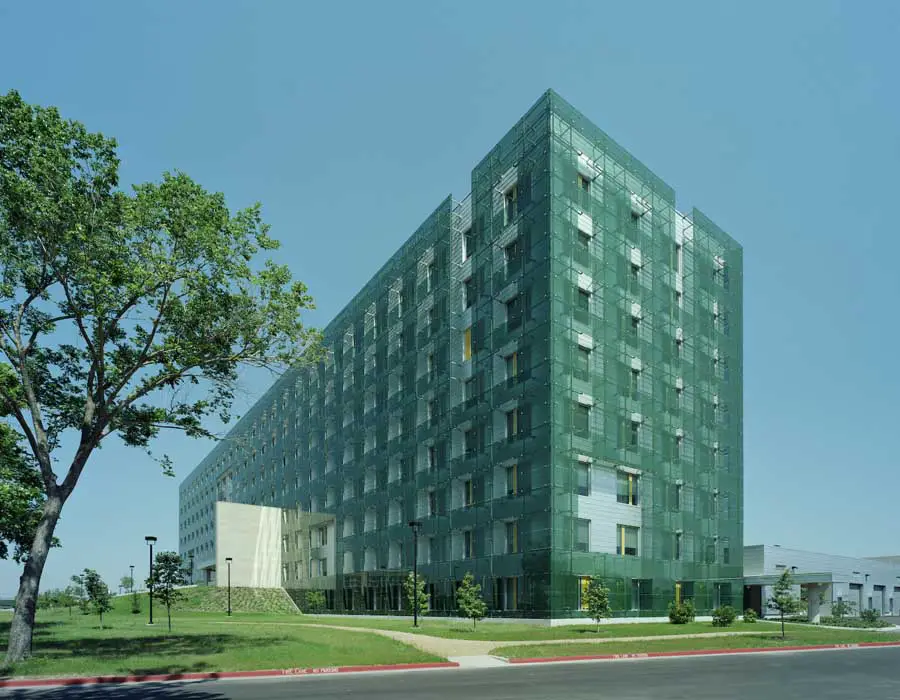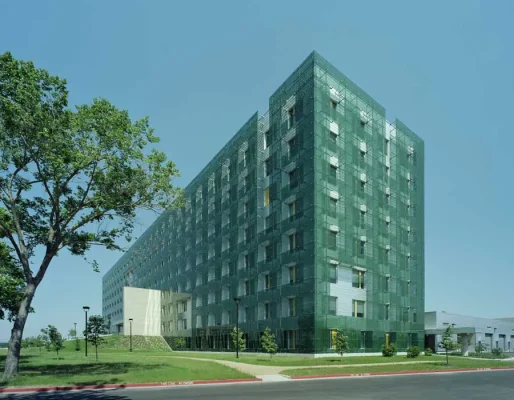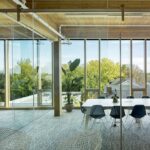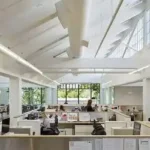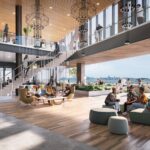General Services Administration Office Building Houston, Texas Architecture, Architects, USA
GSA Field Office Houston
General Services Administration Building, Texas, design by PageSoutherlandPage Architects
Dec 13, 2010
Architect: Lawrence W. Speck, FAIA, PageSoutherlandPage
Photos by Timothy Hursley
GSA Field Office Houston – General Services Administration Building
The design of the new 275,000-square-foot in Houston, Texas, integrates concerns for security, sustainability and appropriate image. The design addresses multiple issues, seamlessly and economically accomplishing a broad range of goals.
The narrow plan responds to climate considerations, presenting broad faces to the south and north, and thin faces to the east and west. Concrete walls are sheathed in aluminum shingles that both reflect heat and allow the high thermal mass of the concrete to provide temperature stability for the structure.
A lightweight metal frame was hung off of the concrete walls to carry a “second skin” for the building on the south, east and west sides. Heavily fritted laminated glass is attached to the lightweight frame with stainless steel clips.
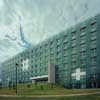

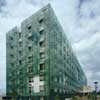
GSA Field Office Houston building pictures from architect
The nearly opaque glass, placed away from the actual thermal wall of the building, shades the structure substantially from direct heat gain from the hot Texas sun. The space between the two skins becomes a significantly cooled microclimate reducing the load requirements for air conditioning systems. In winter, the glass layers enhance the heat-insulating functions of the facade owing to the comparatively higher surface temperatures of the inner surface of the facade.
The north side of the building, where no sun protection is necessary, has no “second skin.” The aluminum surface is fully revealed and is animated by varied window patterns reflecting the extremely divergent view and lighting requirements of functions on this face of the building.
Based on an analysis of sun angles, apertures in the glass skin, sized smaller than the actual windows, are carefully placed to provide excellent day-lighting with reduced glare for interior work spaces. Large window openings – nearly nine feet high – are made of various modules developed so the interior partitions could abut in appropriate places on the very large glazed frames. For building occupants, vision glazing not only admits generous quantities of light but also provides a broader sense of the outdoor landscape, providing a safe and healthy working environment.
The exterior glass skin is carried into the lobby, reinforcing the connection of indoors and outdoors. Security design guidelines were implemented through the use of filtered circulation paths and controlled sequence of spaces that conveys the sense of an “open-door policy” without compromising the safety of the staff.
The high performance building skin is also an image generator. Because of the depth and richness of the building’s surface, its massing could be kept very simple and economical. Aluminum shingles provide a bright, neutral backdrop on which to project the constantly changing light and shadow patterns from the glass skin. Colored a deep, rich green, the glass mutes the bright sun and lends it a striking hue.
The floating, glazed facade aesthetically conveys a sense of lightness that a conventional solid wall cannot. In the lush green context of suburban Houston the color of the building feels natural and integral. Tall cottonwood trees near the building on the south side complement the colors and delicate articulation of its surface.
This careful balance of opacity and transparency, solid and void, closure and aperture, expressed with the articulation of metal and glass, serves to communicate that this is a strong and secure facility that, while protected, is nonetheless welcoming and accessible. By integrating concerns for function, technical performance, and mission-specific requirements into well-synthesized holistic design solutions, the building creates a simple, elegant, and economical building well-suited to its specific purpose and the goals of its agency. The GSA office building is both an inspiring workplace for its employees and an efficient facility for the citizens it is serving.
Sustainable Design / Energy Efficiency
The GSA building has been carefully designed to maximize environmental sensitivity, promote daylighting and views, and provide for the potential of solar energy capture. The heating, ventilation and air conditioning building services infrastructure was designed to provide long-term reliable service, optimized for energy efficient operation in Houston’s hot and humid Gulf Coast climate.
Energy recovery units greatly reduce the energy needed to condition the hot and humid outdoor air while improving indoor air quality for building occupants. Strategic location of CO2 sensors optimizes the delivery of conditioned ventilation air to address occupant demands without operator intervention.
Systems were designed to conserve energy during part-load operation. Equipment utilizes the variable speed technologies to optimize part-load energy efficiencies for pumps, chillers and cooling tower fans. Integrated building management systems communicate and are designed to adapt, allowing for critical tenant functionality during extended periods when utility services are disrupted.
Sustainable design strategies – in addition to the dual skin “microclimate”, daylighting and HVAC systems discussed previously – include:
• Careful location of the buildings and paved areas to preserve several stands of existing trees
• Location of swales and berms to minimize erosion and runoff
• Site selection adjacent to mass transit facilities and above the 500-year floodplain
• Bicycle storage and changing facilities
• Reduction of heat islands via the use of covered parking
• Elimination of visual light pollution by careful specification and location of light fixtures
• Water efficiency through the selection and use of drought-hardy landscaping, rainwater harvesting, low-usage plumbing fixtures and cooling tower water recycling
• Reduction of energy costs through the use of high-performance glass, high insulation values, dedicated energy recovery units, and special selection and design integration of energy efficient HVAC systems, including a full building under-floor HVAC system
• Specification and design that integrate a high percentage of recycled and locally harvested materials
• Exceptional indoor environmental quality that includes CO2 monitoring and low VOCs for all interior materials
• Substrate for future thin-film photovoltaic application (at the discretion of the owner) provided by the screenwall system
57 kbtu/sqft/yr 43% Energy Star %
General Services Administration Office Building images / information from PageSoutherlandPage
Location: Houston, Texas, USA
Texas Buildings by PageSoutherlandPage
Texan Projects by PageSoutherlandPage
Houston Buildings
Discovery Tower – office building, Houston
Gensler
Discovery Tower Houston
Marshall Strabala, Gensler
Houston Ballet
, Houston
Olson Sundberg Kundig Allen Architects
Houston home
Neighbouring State Architecture to Texas
Pecha Kucha Houston Event : Rice Design Alliance
Buildings / photos for the GSA Field Office Houston Architecture design by PageSoutherlandPage Architects in United States of America page welcome.

